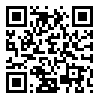Thu, Jan 1, 2026
[Archive]
Volume 12, Issue 1 (Winter 2021)
Caspian J Intern Med 2021, 12(1): 77-83 |
Back to browse issues page
Download citation:
BibTeX | RIS | EndNote | Medlars | ProCite | Reference Manager | RefWorks
Send citation to:



BibTeX | RIS | EndNote | Medlars | ProCite | Reference Manager | RefWorks
Send citation to:
Laghousi D, Rezaie F, alizadeh M, Asghari Jafarabadi M. The eight-item Morisky Medication Adherence Scale: validation of its Persian version in diabetic adults. Caspian J Intern Med 2021; 12 (1) :77-83
URL: http://caspjim.com/article-1-2109-en.html
URL: http://caspjim.com/article-1-2109-en.html
Social Determinant of Health Research Center, Health Management and Safety Promotion Research institute, Tabriz University of Medical Sciences, Tabriz, Iran , dlaghusi@yahoo.com
Abstract: (10107 Views)
Background: Adherence to treatment is an important factor in the management of diabetic patients. The aim of this study was to examine the psychometric properties of the 8-item Morisky Medication Adherence Scale (MMAS-8) among type 2 diabetes.
Methods: This study carried out in Family Medicine Clinics (FMCs) in Tabriz, North West of Iran from May to September 2018. A total of 320 patients suffering from Type 2 diabetes were included. Content and face validity of the Persian version of MMAS-8 were quantitatively evaluated. The Cronbach's alpha and intra-class correlation (ICC) were calculated to assess the reliability. Exploratory factor analysis (EFA) was used to assess the construct validity of the questionnaire.
Results: Content and face validity of the Persian version of MMAS-8 were confirmed. Good internal consistency (Cronbach’s a = 0.83) and test–retest reliability (ICC= 0.87, P<0.001) were found. According to the results of the EFA, Persian version of MMAS-8 among diabetic patients had two dimensions: stopping to take medication due to the forgetfulness and for reasons other than forgetfulness.
Conclusion: The Persian version of the MMAS-8 is a high valid and reliable questionnaire to screen medication adherence of Persian-speaking patients with diabetes.
Methods: This study carried out in Family Medicine Clinics (FMCs) in Tabriz, North West of Iran from May to September 2018. A total of 320 patients suffering from Type 2 diabetes were included. Content and face validity of the Persian version of MMAS-8 were quantitatively evaluated. The Cronbach's alpha and intra-class correlation (ICC) were calculated to assess the reliability. Exploratory factor analysis (EFA) was used to assess the construct validity of the questionnaire.
Results: Content and face validity of the Persian version of MMAS-8 were confirmed. Good internal consistency (Cronbach’s a = 0.83) and test–retest reliability (ICC= 0.87, P<0.001) were found. According to the results of the EFA, Persian version of MMAS-8 among diabetic patients had two dimensions: stopping to take medication due to the forgetfulness and for reasons other than forgetfulness.
Conclusion: The Persian version of the MMAS-8 is a high valid and reliable questionnaire to screen medication adherence of Persian-speaking patients with diabetes.
Policy Brief: Original Article |
Subject:
Endocrinology
Received: 2019/11/4 | Accepted: 2020/02/22 | Published: 2021/01/21
Received: 2019/11/4 | Accepted: 2020/02/22 | Published: 2021/01/21
Send email to the article author
| Rights and permissions | |
 |
This work is licensed under a Creative Commons Attribution-NonCommercial 4.0 International License. |







